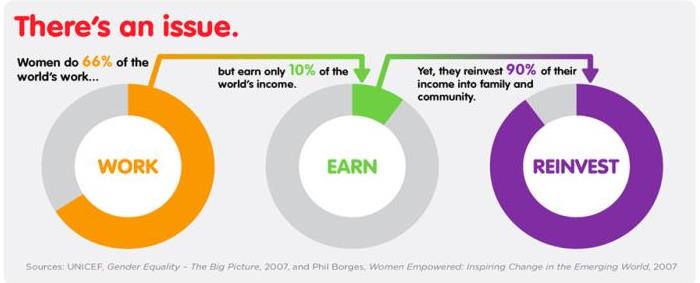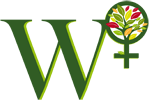
What is the W+™ Standard ?
WOCAN has created the W+™ Standard to accelerate women’s empowerment. The W+ is the world’s first standard to measure positive impacts to women’s social and economic empowerment from projects such as climate change mitigation, adaptation or community development programs. W+ provides measurable and verifiable social benefits, resulting in marketable W+ units or W+ labeled units.
Why create a “Women’s Empowerment Standard” and not a more general “Community” standard?

The following graphic describing the findings of a 2007 UNICEF study illustrates why WOCAN has focused the W+ Standard on women’s empowerment.

How is the W+™ Standard governed?
The W+ Standard is governed by an Advisory Council and a Standard Committee. The Advisory Council provides input on strategy, political landscapes, outreach efforts and connections to their diverse, international professional networks reflecting each member’s unique professional expertise and geographic area. The W+ Standard Committee is an independent body that is a subset of the Advisory Council, composed of specialists to provide expertise, guidance and decisions on standard revisions, methodology approval, rules changes and appeals.
There are many ways a project might improve social and economic circumstances for women. How does the W+ Standard take that into account?
Project developers must show that their projects ‘do no harm’. In addition, they must identify one or more of the six W+ Domains to apply to their project. Project developers include any business, organization or community, or its contracting designee, implementing and administrating projects applying W+.
The W+ domains are: Time, Health, Education & Knowledge, Food Security, Income & Assets, and Leadership. Each one of these six domains may positively influence the other five. In the case of exisiting projects, outcomes on one or more domains can be measured from the past 2 years (The Standard allows back crediting for a maximum of 2 years).
How were these six Domains chosen?
WOCAN has worked with numerous women’s groups in Africa and Asia. Through a consultative process, members of some of these groups in Kenya and Nepal identified these six areas as most important for their empowerment, which could make transformational improvements in the lives of themselves, their families and communities.
What is a W+ TM Unit?
W+ Units represent the quantifiable and realized improvements in a woman’s life, as a result of project activities. These improvements are quantified following a formula designed for each method; and are verified by a third party verifier, based on the W+ Standard requirements. The W+ units can then be sold to corporates, investors, public institutions or individuals. A portion of the revenue goes to women of the project area.This allows project developers and buyers to make a quantifiable impact in the lives of women, while guaranteeing measurable and verifiable results.
What is a W+ Labeled Unit ?
Organizations implementing climate adaptation and mitigation projects can generate W+ labeled carbon units. By applying the W+ Standard to existing or new Clean Development Mechanism (CDM) or Verified Carbon Standard (VCS) registered projects, project developers have the option to create either (not both) W+ labeled carbon units or W+ units. The W+ Standard has partnered with the VCS Program, the leading global standard for the voluntary carbon market, to offer W+ Labeled Verified Carbon Credits (VCUs), jointly labeled under both standards. Because many projects bring multiple benefits to communities, the W+ Standard enables project implementers to integrate women’s empowerment into their projects and quantify the previously unmeasured benefits of their projects.
Are there an unlimited number of W+ Units?
No, there are a finite number of W+ Units for each project, generated each time the project measures and audits their impacts. There is no limit to the number of times a project can repeat the process over the course of multiple years (yearly measurement is not required). Each project generates a limited and quantified number of Units, for each W+ Domain that is measured. Each project applying the W+ Standard is featured on the W+ website and listed on the IHS Markit registry with a unique project and serial number. This online registry enables individuals and intermediaries to track W+ certified projects and issue, transact and retire W+ units, ensuring that units are never “double sold”.
Regarding Project Implementation
What kinds of projects can the W+ Standard be applied to?
In theory, the types of projects are limited only by a project developer’s imagination and vision, within projects that have direct engagement with communities. However, the W+ was created with women in developing economies in mind. Therefore, some common types of community and economic development projects, where the W+ Standard may be most suited are:
- Renewable energy technologies
- Climate change mitigation and adaptation
- Time and labor-saving devices
- Forest and agriculture activities
- Water production or treatment
- Financial literacy and banking access
- Employment opportunities
- Educational programs
- Community development
How does the W+ Standard relate to climate change mitigation projects?
The W+ Standard was inspired – in part – by new market-based opportunities to recognize and reward contributions of women and to generate more benefits for women and communities where climate change mitigation projects are implemented. We think climate change mitigation and women’s empowerment are often a natural fit. There are two ways the W+ Standard may be applied in a project that is measuring carbon:
The W+ may be applied to a project where activities issuing carbon credits are producing results for women’s empowerment alongside. An example is an agro-forestry project that generates carbon units and separate W+ Income & Assets units because of new economic opportunities for women presented by the project’s activities.
The W+ may be applied to a climate change mitigation project that recognizes that their carbon mitigation measures are activities that also result in measurable beneficial outcomes to women, as co-benefits. An example might be; a domestic biogas program that results in significant time savings for women. The project developer can choose to ‘label’ their resulting carbon credits as a carbon credit with a W+ Time label.
Project developers may design ‘mix and match’ projects by creating some stand-alone W+ units and some W+ labeled carbon units. But they must differentiate the benefits associated with labeled carbon units with those defined as stand-alone W+ units to prevent double-counting.
Can I apply the W+ Standard to existing projects?
Yes. A project developer can apply the W+ Standard retrospectively and may back-credit measurable benefits for up to two years.
How do I apply for W+ ?
Project developers should assess how the W+ can be integrated into their project (benefits of project activities to women) and contact the W+ Coordinator (coordinator@wplus.org). Based on this initial assessment, Project developers can prepare the Project Idea Note (PIN) that will enable them to register their project under W+, then prepare the Project Design Document (PDD), which will include more detailed information about the project, using the PDD template that is provided by the W+ Standard. Project Implementers must plan for and measure progress in at least one of the six domains: Income & Assets, Time, Education and Knowledge, Leadership, Food Security and Health. The PIN and PDD are reviewed by the W+ Coordinator. A third party gender expert also reviews the PDD.
Templates and instructions for filling out the PIN and PDD are found on the requirements page.
Once there are visible results, a measurement survey is undertaken to measure and quantify the benefits to women. Those benefits will be verified by an independent accredited W+ verifier. Organizations/projects that have obtained satisfactory results will be issued a certain number of W+ units, which will be listed on IHS Markit registry.
How do you determine the number of W+ Units each project will generate?
The number of W+ units generated depends on the number of women receiving benefits, and the level of impact for each domain used. The impact is measured following a formula designed for each method. The specific number of units is then determined as follows: 1 W+ unit = 10 % improvement in one woman’s life per domain for the period measured; results are verified by a accredited W+ verifier.
I want to create a project, but I don’t think I want to sell W+ Units. Can I simply display the positive impacts of my project on my own project’s website?
Yes, that is certainly permissible. However, to be able to claim quantifiable benefits and compliance with the W+ Standard, women of the project communities must receive monetary benefits to recognize the contributions they made to successful project outcomes. This amounts to a minimum of 20% of the value of the units. There are numerous ways you could distribute these benefits, that we can discuss with you.
Is it required to conduct yearly measurement and auditing?
Yearly measurement and auditing is not required. W+ Units have a “vintage” associated with a monitoring period which is established by the project developer – the Standard does not stipulate a yearly reporting requirement. That way the viewer or buyer understands the timeframe for each monitoring period, and the units generated by the project’s activities during that period. For example, a project might report: “From May ’16 to December ’16 the Bright Lights project generated 110,000 Health units and 134,000 Time units.”
How long does it take for a project to receive a W+ certification?
Project developers decide what their schedule for measurement should be at the time of the Project Design Document. It should be a long enough period to provide significant and verifiable results, but it can be less than one year.
How does the W+ assure that money is shared with the women in project communities?
The W+ Standard requires each project developer to ensure they have established a locally appropriate, secure and auditable mechanism to make payments to women or women’s groups in the project community. The specific mechanism will vary from project-to-project, and is determined at the time of the Project Design Document preparation. Project developers must ensure that the funds are distributed through a reliable channel, which is verified during the second measurement period. We can work with project developers to suggest appropriate mechanisms. Once funds are received, women in the project community will have additional resources, that they will use to meet their self-determined needs- an important aspects of women’s leadership and empowerment supported by the W+ Standard. Read the Tool for Monitoring, Reporting and Verification of Financial Payments to Primary Beneficiaries as a result of a Project or Program Level Intervention for more information.
Are project developers required to hire gender consultants?
No. Projects may go through the W+ process with their own personnel, using resources of the W+ Standard made available to registered users (project developers who have submitted a Project Idea Note). Technical assistance is available for organizations and project developers that have limited knowledge and skills to measure women’s empowerment.
As a project developer, do I need to develop my own set of indicators?
No. Methods for measuring results within the 6 Domains have been developed and field-tested by WOCAN and its team of W+ experts, for various types of projects. After registering for the W+ Standard, project developers have access to the questionnaires developed for each domain, which they can refine as per their own contexts. Altered methods will require approval by the W+ prior to verification.
Regarding Purchasing W+ Units
Who are the buyers of W+ Units or W+ labeled carbon units?
Many organizations and individuals are interested in finding meaningful and measurable ways to support action on women’s empowerment, climate change mitigation or adaptation, or in making a positive contribution to the Sustainable Development Goals (SDGs). Buying W+ units or W+ labeled units can demonstrate the commitments of organizations: companies, governments, charities/philanthropic organizations, and investors to women’s empowerment and gender equality, and provide quantified results towards their targets for SDG #5. Investors can use these purchases as proof that their financial support has made a measurable difference towards their social goals.
If I buy W+ Units, what do I get and what good does it do?
The W+ Unit is a social good, that represents the social and economic value of project impacts on women. Purchasing these social goods drives positive social and economic change for women, their families and communities in two ways: providing more benefits through project activities, and through the benefit-sharing requirement of the Standard. A requirement of the Standard is the sharing of at least 20% of the value of W+ Units to the women and women’s groups in project communities.
Project implementers identify, implement and monitor the results of related activities according to a well-defined plan; these results are audited on-site by independent W+ accreditated auditors. Unlike donating to a cause or project up-front, your purchase of a W+ Unit means you are paying for the results – not only the activities that may or may not lead to those results. Your purchase ensures that women in the project community will have additional resources, that they will use to meet their self-determined needs – an important aspect of women’s leadership and empowerment supported by the W+ Standard.
Buying W+ units thus:
- supports and empowers women in two ways: through additional benefits from project activities, and through cash payments that are used as per the needs determined by women
- directly compensates Project Implementers for their investments to support women’s empowerment and for costs to apply the W+ Standard
- ensures that Project Implementers are rewarded for their initiative and encourages a virtuous cycle of additional activities for women’s empowerment.
If women are benefitting from the projects, why are they also getting money from W+ Unit sales?
Women contribute significant unrecognized and uncompensated labor and time to the maintenance of their families and households– as care-providers, farmers and natural resource managers, and laborers. In addition to this unpaid care or work labor, women provide substantial inputs to development aid projects, environmental services, water or public health projects that benefit communities, countries and the planet. It has also been found that when women are provided with monetary resources, they are far more likely to spend that money to serve their families and their community’s needs than men often do (The Forum on Public Policy, 2009). By requiring that a portion of the revenues from the sale of W+ Units go to women, the W+ Standard is helping the world recognize the value of women’s work, and providing women in project communities resources which they will re-invest in their families and communities, based on their OWN determination of needs and opportunities, creating a virtuous cycle of improvement.
Regarding W+ Verifiers and Verification
How do I become a W+ approved verifier?
WOCAN has accredited the Social Auditor’s Network (SAN) as the first W+ Standard Verification Body. SAN certifies individuals as W+ Verifiers who satisfy their requirement through a process of training and shadow auditing. Please contact SAN directly if you are interested or would like more information about the W+ Standard Verification Process.
I want to create a project. Can I do my own verification?
No. Third-party (independent) verification is a requirement of the W+ Standard. Please refer to the W+ website for a list of W+ approved/accredited verifiers.
